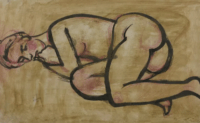Max Lacher
Max Lacher (b. July 18, 1905, Munich; d. 1988, Munich) was a versatile German painter. After completing his secondary education in 1923, he studied for two semesters at the Munich School of Applied Arts and later with Julius Diez at the Academy of Fine Arts in Munich. In 1926, he moved to Paris, working independently, and then took up portrait painting in Hanover and Berlin before returning to Munich in 1930. He received the Albrecht Dürer Prize from the city of Nuremberg in 1921. During the Great Depression, Lacher made a living through commercial art, including window displays and signage.
From 1935, he undertook various commissions for public buildings and won numerous competitions for wall decorations, stained glass windows, and mosaics. During the Nazi era, he refrained from exhibiting his works, as he was denied a professorship at the Cologne School of Applied Arts due to his refusal to join the NSDAP. Drafted into infantry service in 1940, he earned an interpreter’s certificate in Paris in 1943 and served as a translator in France. His Munich studio, along with much of his early work, was destroyed in a bombing raid during this time.
In 1945, he joined the Bavarian Freedom Action resistance group and was sentenced to death in absentia. After the war, Lacher took on various organizational roles in Munich’s art scene, joined the Munich Secession, and led exhibitions at the Haus der Kunst, where he served as president multiple times. His works were exhibited nationally and internationally, including in the Städtische Galerie im Lenbachhaus and the Munich Art Association. In recognition of his contributions, he received the Federal Cross of Merit, First Class, in 1969, the Seerosen Prize in 1974, and the Munich Shines Medal in Gold in 1985.
Lacher’s artistic approach was highly experimental: he mastered techniques such as etching, lithography, glass engraving, slate cutting, mosaics, stucco marble, frescoes, and reverse glass painting. His subjects ranged from still lifes, landscapes, portraits, mythological and biblical figures to everyday scenes. His public works included wall decorations and stained glass for churches, public offices, and schools. His works are part of the collections of the Bavarian State Painting Collections, the Städtische Galerie im Lenbachhaus, and the Munich City Museum.
Showing all 3 resultsSorted by latest
-
„auf Elba“, 1962 | Aquarell von Max Lacher
Max Lacher (1905 – 1988)
-
„Allgäuer Bauernhof“, 1973 | Aquarell von Max Lacher
Max Lacher (1905 – 1988)
-
Liegender Frauenakt, 1960 | Gemälde von Max Lacher
Max Lacher (1905 – 1988)



